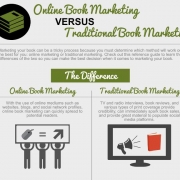Book Marketing Strategies to Stand Out in a Crowded Field
5 Ways to Sell More Books and Get Ahead

Two somewhat opposing forces are driving the book marketing world today. The first one is opportunity, and the second one is competition.
Therefore, successful authors and publishers must find a way to take advantage of opportunities and overcome the competition.
Why is there more opportunity? When people were stuck at home during the coronavirus pandemic, they filled some of their extra time by consuming media, books included. Those habits have continued. Also, quite happily for the book industry, many young people today are increasingly interested in books and read voraciously.
What is causing the increased competition? Authors who self-publish their work become more numerous each year, hybrid publishing is growing, and traditional publishers release thousands of new titles annually. Taken together, it’s an avalanche of new books hitting the market month after month.
How Can I Ensure My Book Will Succeed?
If you plan to self-publish your work, success begins with writing an outstanding book. But then you need to be on top of many other details. Most of them are things traditional publishers provide for their authors:
- Excellent cover design
- Professional editing and inside formatting
- High-quality printing
- Well-planned book marketing – traditional media + online
- Author branding
An ever-increasing number of readers are willing to seriously consider self-published books when they measure up against others from big-time publishers. Therefore, you must be careful to do the things proven to support a book’s success.
1. Have a Strong, Eye-Catching Cover

Why is book cover design specialized? Like anything else, there are dos and don’ts. For example, the color of your book cover can immediately give people an impression of your book. Good design will nearly always incorporate green to match money if you’ve written about money or personal finance.
The typography selected for your cover needs to fit the topic, the book’s spine needs to have the required information, and the whole design needs to reproduce well in “thumbnail” size, as people buying your book online will browse pages that show your cover in a thumbnail version.
2. Work with a Professional Editor
Book editors are second only to the author in assuring high-quality content. If you’re a novelist or other fiction writer, they will help with the progression of your story. For non-fiction books, the editor helps ensure good content flow, organization, and a clear topic presentation.
Tip: The inside formatting of your book matters. It enhances readability and gives readers an impression of overall quality. After editing, have the text professionally formatted.
The editor-author relationship is crucial. An open and insightful dialog helps make your book polished and professional. Strong editing is the foundation of a high-quality, competitive book.
When interviewing prospective editors, focus on people with experience in your genre. Most good editors will only accept projects in their areas of expertise. Personal rapport also matters, and it helps to find someone you enjoy working with.
3. Explore Your Book Printing Options
For reasons of convenience and less financial responsibility, many self-published authors elect to stay within the print-on-demand system. If it’s your best decision, then you work within its parameters. But you can also explore printing your book conventionally. Either way, ask about your options:
- Choice of digital or money-saving offset printing for larger print runs
- Hardcover and paperback bindings
- Flexibility with trim sizes
What is most important is printing a book that upholds your vision, will appeal to target readers, and will make an excellent impression for book marketing and sales.
Did you know about 80 percent of books are read as physical copies? Given the statistics, how to print your book is a decision to weigh carefully. You want to produce a book people want to buy.
4. Plan a Strong Book Marketing Program
Publicizing and promoting your book effectively is the best way to make it stand out in a crowded market. Book marketing campaigns should be strategically planned and ready before your publication date.
- Strongly consider hiring professional book marketing support
- Include traditional and online media in your campaign
- Leverage in-person and virtual touring
- Consider media training to improve your skills
- Develop key messages to engage target readers
- Be flexible with scheduling and readily available to the media
Marketing your book with a mix of traditional and online media is the gold standard. They work hand in hand to improve discoverability and ensure target readers choose you over the competition. The online portion of your campaign needs to be as well-rounded as the media campaign.
- Launch a well-designed website with the right content
- Consider a blog and podcast series or guest appearances
- Coordinate social media posts with your book PR campaign
- Complete book and author pages with online booksellers
Everything you do for your book before its launch (cover design, editing, high-quality printing) supports the marketing program. Book promotion is incremental and works best when you get things right with many details. They will all work together to achieve success.
5. Take Author Branding Seriously
Branding is one of the most powerful concepts in marketing, and the book industry’s version of it is author branding. It means establishing yourself as a presence that readers and the media understand to mean something specific – genre, writing style, expertise, etc. It helps to sell books and opens many doors.
Tip: To learn more from the experts, view Smith Publicity’s webinar on author branding.
Book publicity programs send you as an author on tour to represent your book. Each appearance and the coverage it generates builds your brand. The same goes for your website and social media. They work together to help people develop an understanding of your brand.
Having a recognizable author brand helps future books and allows you to branch out beyond writing into other areas if you choose.
Conclusion: Making Your Book Visible in a Competitive Marketplace

Marketing your book in a competitive environment is challenging, but when you meet it head-on, target readers will discover your work. You’ll sell copies and downloads and build your author brand when they do. You’ve put a lot of time and effort into writing your book; make sure it pays off.
Looking for more information about book marketing? Check out the Smith Publicity blog here.






